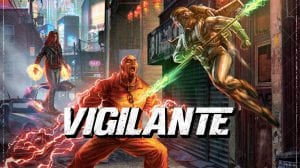With all the silly themes we get in board gaming, it’s a little weird to see cryptozoology as one of the few that isn’t touched very often. You would assume this would be the perfect theme for a hidden movement game instead of the typical pursuit of criminals, murderers, and vampires we are used to seeing. The next best step would be a deduction game with the players trying to hunt these elusive beasts and this is where Cryptid comes into play.
Before we discuss mechanisms, we need to talk about the beautiful map. The map is modular with various pieces along with a deck of map cards to instruct you on the setup. These maps contain various elements such as terrain types, animal territories, the color of the structures, and what types of structures. After the map has been set up, each player will be given one clue related to one of these elements such as “On Forest or Swamp” or something annoying like “two spaces away from an Abandoned Shack”
Back To Back Questions
From there, each player will place two cubes on the board. These cubes cannot be related to their clue, so these cubes represent a “negative” meaning it impossible for the creature to be there. There is one spot on the entire board which matches everyone’s clues and that is the solution to this puzzle. Yes, you are playing with a game based on an algorithm.
On your turn, you are going to do one out of two simple things: Ask a question, or search. Asking involves you selecting an area on the map and ask another player if the Cryptid could be there. The other player must answer truthfully based on their clue and will either put a disc or a cube. If it’s a yes, they put a disc here and get a little worried. Otherwise, a “no” will be announced followed by them proudly placing their cube down and a short smile. Since they placed a cube, you must also place one.

Searching is a bit of the reverse. You have to pick a spot related to your clue and put down a disc. Going clockwise, each player must place either a disc or cube, one at a time. If any player puts down a cube, the search immediately ends and you must place a cube. On the other hand, if everyone’s discs are in the spot you’ve searched, you win. Congratulations.
Pretty easy, right? This is a good example of an intelligent gateway game that can be played by anyone. All these ingredients baked into this wonderful dessert that allows this mixture of deception and deduction. You will use your cubes to throw the players off into a wild goose hunt while using your opponents’ discs to figure out a pattern.
It’s not an easy task to handle both sides of the game. Your cubes are going to be the most placed piece and you need to come up with a convincing narrative to trick other players using only the placement of your cubes. As for those discs, you need to constantly prod and theorize what element on the board is triggering these discs like a grade 2 science project. Sometimes you’ll get it quickly and everything goes smoothly, but that barely happens. What’s likely going to happen is you think that one element, let’s say two spaces from a shack, is triggering the disc, so you search and they place a cube. Oh no…
It is hard to say this game failed at its intentions. The aim was to create a luckless deduction game with only persistent logic as the main drive and it nailed this harder than a veteran carpenter. When this puzzle is eventually solved by one of the players, foreheads will be slapped and groans will be heard as the foggy clues become as clear as hand-washed crystal glass.
Yet I wouldn’t own this game unless I can get it a deep discount.

Maybe A Little Too Repetitive
All of this stuff that I have mentioned so far doesn’t change from game to game. The structure and arc are always the same. You will use cubes to mislead, discs to figure out a pattern, conduct searches, and hope for the best. Rinse and repeat. It’s like having boiled chicken from morning to night, every day.
Now I know there is an argument about the maps and this illusion is easy to see through. You do have a modular map with a deck of cards and you can also visit the website for more maps. The issue is the placement of elements does not change the game itself. Unlike other games with randomized maps, the elements presented here don’t have any mechanisms tied to them. It’s just another trait that could potentially generate those discs.
There is an advanced version where players might be given inverse clues such as “Not within two spaces of a standing stone” and adds the black structures. I’ll admit this does make it challenging for the deduction portion, however, this doesn’t change how the game is played drastically. Unlike other games with randomized setups, this one doesn’t force me to re-evaluate the situation. Again, we are walking on the same path to the same destination only with different colored scenery.
This leaves Cryptid in this grey area that I hate as a guy who spends way too much time writing about board games. My only compromise in this situation is to give two answers.
If what I wrote sounds exciting, money isn’t a problem and the repetitive gameplay is fine with you, I suggest checking this game out. This is a platinum example of game designers being clever creatures able to make simple cardboard tiles and wooden pieces into an engaging experience. As a gateway game, I found this to be far more enjoyable than many other gateway games that often get put on this ridiculous pedestal.
Now for those of you who are crazy like me who like to deep dive and not only want to eat the meat but digest the bone, there are some concerns. It is a repetitive game that will lose its novelty quickly. This is not an extremely deep game that constantly tests you out like many other games you have played before. At most, this is a game that you can enjoy occasionally with your friends instead of deciphering the intricacies the designer has embedded in the mechanisms. It’s fun but a little shallow.











Add Comment